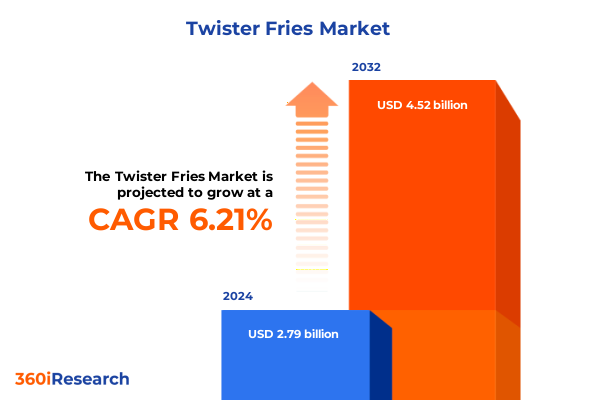The Twister Fries Market size was estimated at USD 2.79 billion in 2024 and expected to reach USD 2.96 billion in 2025, at a CAGR of 6.21% to reach USD 4.52 billion by 2032.

Unlocking the Spiral-Cut Sensation: An Overview of the Twister Fries Market Landscape Amidst Evolving Consumer Demands and Channel Innovations
In recent years, the frozen food aisle has transformed from a practical convenience into a strategic battleground for brands aiming to capture consumer loyalty. Among these, Twister fries-spiral-cut potato snacks that combine playful form with indulgent taste-have emerged as a standout segment. Driven by heightened demand for on-the-go options, these crispy spirals have found a foothold in both home kitchens and commercial venues, riding the broader wave of frozen foods that saw a surge of health-focused innovation and flavor variety in early 2025.
As consumers embrace modern health paradigms, manufacturers have responded by reformulating core products with cleaner ingredient lists and reduced oil content, leveraging alternative cooking technologies without sacrificing texture. The intersection of convenience, playful presentation, and premium sensorial experiences positions Twister fries at the nexus of two powerful consumer trends: nostalgic indulgence and wellness-oriented snacking.
Navigating Rapid Transformations: How Consumer Health Priorities and Technological Advancements Are Reshaping the Twister Fries Industry
The Twister fries category is experiencing transformative shifts driven by health consciousness, technological integration, and palate diversification. Nutrition-forward offerings, such as air-fried adaptations with minimal added oils, have gained traction among consumers seeking guilt-free indulgences, reflecting a broader appetite for products that balance flavor with perceived health benefits. Concurrently, the adoption of air fryers and convection ovens in household and foodservice settings has redefined cooking protocols for frozen snacks, enabling consistent results while addressing concerns over excess calories and saturated fats.
Alongside these health-centric developments, global flavors continue to reshape formulation strategies. Inspired by spicy Asian condiments, smoky Mediterranean herbs, and Latin American chilies, Twister fries innovators are infusing profiles that resonate with adventurous younger cohorts. This fusion of novel seasoning techniques and alternative cooking methods underscores an industry pivot toward experiential snacking that transcends pure utility.
Assessing the Ripple Effect of 2025 U.S. Tariff Escalations on Twister Fries Supply Chains and Ingredient Economics
The policy landscape of 2025 introduced elevated tariff barriers that reverberated across the frozen potato supply chain. In early March, the United States enacted a 25 percent levy on imports from Canada and Mexico, coupled with an additional escalation of duties on Chinese agricultural goods, raising the average duty rate across key trading partners to double-digit territory. These measures, aimed at addressing trade imbalances and border security, inadvertently increased landed costs for frozen potato processors, including those producing Twister fries.
In response, manufacturers and foodservice operators have been forced to adapt by diversifying sourcing strategies and renegotiating supply agreements. While certain agricultural inputs, such as fertilizers and select crop protection tools, received carve-out exemptions to mitigate agricultural cost pressures , frozen potato processors continue to grapple with higher raw material costs. Consequently, many have accelerated investments in domestic processing capacity and optimized logistical networks to preserve margin integrity without diluting product quality.
Delving Into Targeted Market Segmentation Insights to Reveal Growth Opportunities Across Channels, Formats, and Consumer Preferences
An in-depth segmentation analysis illuminates clear pathways for targeted growth within the Twister fries category. When considering distribution channels, the Quick Service Restaurant environment stands out for its subdivided appeal across burger, chicken, and pizza chain formats, each demanding tailored product specifications and flavor profiles. Within retail, supermarket hypermarkets drive volume through family-oriented bulk offerings, while convenience stores and online retailers cater to impulse and specialty segments, respectively. Full service restaurants seek premium presentations and customized seasoning blends to differentiate menu offerings.
Product format diversity further enriches market opportunities. Stand-alone categories-curly, shoestring, spiral twist, and waffle fries-cater to distinct texture preferences and emotive associations. Cooking methods add another layer of customization: air-fried and baked formats appeal to health-minded consumers, deep-fried variants satisfy traditional indulgence cravings, and microwave options deliver a blend of speed and convenience for on-demand preparations. End users bifurcate into foodservice channels-encompassing catering services as well as dine-in and takeout venues-and household purchasers, each requiring differentiated packaging configurations from single-serve to family multipacks. Flavor innovations span fundamentals like salted and cheese variants to seasoned profiles such as barbecue, where smoky and spicy notes satisfy evolving taste palettes. Packaging also plays a pivotal role, with choices ranging from bulk cases for high-volume operations to premium single-serve formats for snacking occasions.
This comprehensive research report categorizes the Twister Fries market into clearly defined segments, providing a detailed analysis of emerging trends and precise revenue forecasts to support strategic decision-making.
- Product Type
- Cooking Method
- Flavor
- Packaging Type
- Distribution Channel
- End User
Mapping Regional Nuances: How Divergent Economic Drivers and Cultural Preferences Influence Twister Fries Demand Across the Globe
Regional dynamics exert a profound influence on Twister fries performance, with each macro-region shaped by unique cultural, economic, and infrastructural factors. In the Americas, the long-standing affinity for potato-based snacks has been reinvigorated by collaborations with quick service and fast casual restaurants, where spiral-cut formats deliver novelty and shareability. Retailers in North America have bolstered private label expansions and exclusive flavor launches, supporting sustained category momentum and rental foot traffic in frozen aisles.
Across Europe, the Middle East, and Africa, an emphasis on organic sourcing, sustainable packaging, and artisanal seasoning profiles has elevated consumer expectations. European operators pioneer premium potato varieties and traceable supply chain disclosures, while emerging markets in the Middle East integrate locally resonant spices. In Asia-Pacific, rapid urbanization and expanding quick service footprints are driving pizza, burger, and chicken chains to adopt Twister fries as complementary side offerings. Moreover, increasing refrigerator and freezer penetration in both retail and foodservice outlets, combined with growing familiarity with air fryer appliances, is reinforcing broader category acceptance.
This comprehensive research report examines key regions that drive the evolution of the Twister Fries market, offering deep insights into regional trends, growth factors, and industry developments that are influencing market performance.
- Americas
- Europe, Middle East & Africa
- Asia-Pacific
Profiling Industry Leaders and Emerging Innovators Driving Competitive Dynamics in the Twister Fries Marketplace
The Twister fries category is dominated by a handful of multinational processors whose scale and innovation pipelines shape competitive dynamics. McCain Foods holds an unparalleled position as the world’s largest frozen potato processor, leveraging over fifty production sites across six continents to deliver consistent quality and seasonal continuity. Its commitment to regenerative agriculture initiatives and energy-efficient operations underpins a robust brand reputation among both foodservice chains and retail partners.
Lamb Weston, J.R. Simplot Company, and regional players such as Aviko further intensify market competition. Lamb Weston drives growth through international expansion and texture-enhancing processing technologies, while J.R. Simplot’s integrated supply chain offers efficiencies that translate into rapid innovation cycles for spiral-cut and specialty formats. Aviko, with strong footholds in European and select Asia-Pacific markets, focuses on premium and organic product lines, reinforcing its appeal within health-oriented and convenience segments. This constellation of leading processors continues to invest in R&D, co-branding opportunities, and automation enhancements to maintain differentiation.
This comprehensive research report delivers an in-depth overview of the principal market players in the Twister Fries market, evaluating their market share, strategic initiatives, and competitive positioning to illuminate the factors shaping the competitive landscape.
- Lamb Weston Holdings, Inc.
- McCain Foods Limited
- J.R. Simplot Company
- Aviko B.V.
- Farm Frites International B.V.
- Cavendish Farms
- Agristo NV
- Nomad Foods Limited
- Kraft Heinz Company
- Conagra Brands, Inc.
- General Mills, Inc.
- Pinguin Lutosa
- Greenyard NV
- Himalya International Ltd.
- Iscon Balaji Foods Private Limited
- Bart's Potato Company B.V.
- Landlord Food Products, Inc.
- Alexia Foods, Inc.
- Bem Brasil Alimentos LTDA
- The Little Potato Company Ltd.
- Inventure Foods, Inc.
- H.J. Heinz Company Brands LLC
- Universal Frozen Foods, Inc.
Developing Strategic Action Plans to Capitalize on Evolving Consumer Behaviors and Supply Chain Realities in the Twister Fries Sector
To thrive amid evolving supply chain challenges and shifting consumer expectations, industry stakeholders must adopt a multi-pronged strategic framework. First, aligning product development with health trends-such as reduced-oil air-fried offerings and functional seasoning blends-will reinforce brand relevance. Concurrently, expanding private label and exclusive co-branded partnerships with quick service and retail outlets can secure differentiated shelf space and menu prominence.
Second, mitigating tariff exposure through diversified ingredient sourcing and enhanced onshore processing capabilities will preserve cost competitiveness. Strengthening supplier alliances and exploring alternative potato varieties can reduce reliance on high-tariff imports. Finally, investing in data-driven marketing initiatives that leverage consumer insights from digital platforms will ensure messaging resonates with target personas, thereby driving trial and fostering brand loyalty in a crowded marketplace.
Outlining a Robust Research Blueprint Integrating Multi-Source Data Collection and Analytical Rigor for Unbiased Market Assessment
This report synthesizes a dual-approach research methodology combining comprehensive secondary data aggregation with targeted primary stakeholder engagement. Secondary inputs encompass industry publications, trade association bulletins, regulatory filings, and reputable business news outlets, ensuring a robust contextual foundation. Concurrently, the research team conducted in-depth interviews with leading frozen food manufacturers, foodservice executives, distribution partners, and equipment suppliers, yielding nuanced perspectives on operational challenges and growth opportunities.
Data triangulation was applied to reconcile insights across multiple sources, enhancing reliability and validity. Quantitative analysis of distribution channel performance, segment adoption, and frequency metrics was complemented by qualitative trend mapping and expert validation. The methodology adheres to rigorous standards of transparency, reproducibility, and impartiality, equipping decision-makers with a defendable intelligence base.
This section provides a structured overview of the report, outlining key chapters and topics covered for easy reference in our Twister Fries market comprehensive research report.
- Preface
- Research Methodology
- Executive Summary
- Market Overview
- Market Insights
- Cumulative Impact of United States Tariffs 2025
- Cumulative Impact of Artificial Intelligence 2025
- Twister Fries Market, by Product Type
- Twister Fries Market, by Cooking Method
- Twister Fries Market, by Flavor
- Twister Fries Market, by Packaging Type
- Twister Fries Market, by Distribution Channel
- Twister Fries Market, by End User
- Twister Fries Market, by Region
- Twister Fries Market, by Group
- Twister Fries Market, by Country
- Competitive Landscape
- List of Figures [Total: 32]
- List of Tables [Total: 687 ]
Synthesis of Findings Highlighting Core Trends, Challenges, and Opportunities Shaping the Future of the Twister Fries Market
The synthesis of this executive summary underscores the Twister fries segment as a dynamic fusion of convenience, innovation, and premiumization. Consumer demand for health-oriented cooking methods, coupled with appetite for global flavors, continues to drive product reinvention. At the same time, trade policy uncertainties and tariff escalations necessitate agile supply chain recalibrations.
Looking forward, manufacturers and channel partners that embrace diversified distribution strategies, reinforce cost-optimization through onshore processing, and leverage consumer intelligence for targeted product innovation will be best positioned to capitalize on the category’s momentum. The confluence of these strategic imperatives sets the stage for sustained growth in what is poised to be one of the most dynamic snack segments of the decade.
Secure Your Competitive Edge by Connecting with Ketan Rohom for Exclusive Twister Fries Market Intelligence
Harnessing the insights and strategic depth of this comprehensive analysis empowers you to make informed decisions that secure a leadership position in the dynamic Twister fries market. To obtain the full report and unlock detailed data, trend analyses, and actionable intelligence, reach out directly to Ketan Rohom (Associate Director, Sales & Marketing) and position your organization to capitalize on emerging opportunities.

- How big is the Twister Fries Market?
- What is the Twister Fries Market growth?
- When do I get the report?
- In what format does this report get delivered to me?
- How long has 360iResearch been around?
- What if I have a question about your reports?
- Can I share this report with my team?
- Can I use your research in my presentation?




